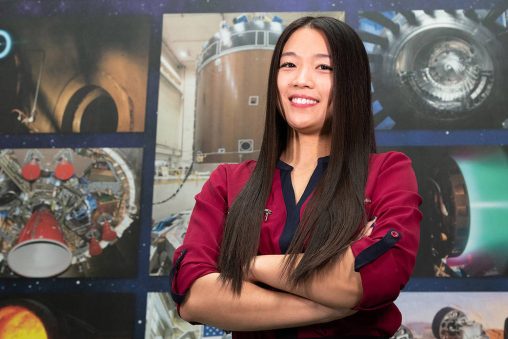
Wright State computer engineering graduate Phuong Marangoni plays key role in NASA’s mission to return to the moon.
When Wright State University alumna Phuong Marangoni graduated, she never expected to launch a career at NASA.
Marangoni, who graduated from Wright State with a bachelor’s degree in computer engineering, is the deputy project planning and control lead for the NASA Gateway Power and Propulsion Element (PPE) Project at NASA’s Glenn Research Center in Cleveland.
A cornerstone of NASA’s Artemis Program — which aims to land the first woman and the first person of color on the moon — is an orbiting lunar space station called Gateway and its power and propulsion element, which provides power, high-rate communications and propulsion to Gateway for deep space transit, orbital transfer and station keeping.
Marangoni’s team is responsible for a range of areas including project life cycle, cost and schedule, audits and export control, among others. She helps with the integration of those programmatic activities with the management and engineering teams.
“To this day I still pinch myself that I get to work for NASA and even more so, get to be part of a project that is helping us build a space station for the moon,” she said. “I feel very blessed and work with a fantastic, hardworking team.”
After graduating from Wright State, Marangoni worked as a software engineer developing tools for various Department of Defense projects. She subsequently found herself in a project office that gave her the opportunity to transition into a management role as she took on more programmatic responsibilities.
“That opened my horizons into a management career that I didn’t really plan for but have found to be quite enjoyable,” she said.
To assist in her career pursuits, she pursued a master’s degree in engineering management from Penn State University and eventually landed at NASA.
What makes Marangoni’s achievements even more remarkable is that she comes from such humble beginnings. She immigrated to the United States, settling in Ohio, with her family from Vietnam when she was a young girl. Although her parents were hardworking, the word that comes to mind when thinking of her upbringing is “minimal.” Toys were borrowed from other kids and clothes worn by her and her sisters were secondhand from family friends.
“My parents rarely bought us gifts as they felt money was better spent ensuring we did not go a day hungry,” she said.
Moreover, life in a new country provided its conundrums.
“I had a very interesting childhood,” Marangoni said. “It was a mix of two cultures that I learned to adapt to, and it helped me develop a resiliency to overcome new and unknown situations. I have embraced this multicultural experience and gained more compassion and gratitude along the way.”
While she was well-acquainted with the many complexities that composed her life, the one constant was how vigorously her parents stressed education. Marangoni’s older sister attended Wright State and because it was affordable and had an acclaimed College of Engineering and Computer Science, she decided to follow suit.
“My experience at WSU I would say was a mix of some highest of highs but also challenging times,” she said. “I met some lifelong friends and my husband there, and got a wonderful degree in the end, but of course, it did not come easy. There were many late nights in the Russ Engineering labs working on projects, stressing out or in the Student Union studying with my fellow classmates and friends.”
Marangoni admits her career path has been somewhat unexpected.
Initially, she desired to be a police officer but changed course in middle school due to her love of art. While also in middle school, her parents discovered a free STEM summer program that inspired her interest in a technological career. With more exposure to engineering in high school, she first leaned toward architecture before settling on computer engineering.
“I did not choose art simply because I viewed it as a hobby, but it was a tough decision,” she said. “I was a polymer clay artist for a brief period, making and selling miniature clay foods for dolls and wearable clay jewelry. As my tech career continued to blossom though, I eventually lacked the time and the energy to keep up with my artistic endeavors.”
The advice she would give to students contemplating a STEM career is that while it’s not an easy field, it is a very rewarding one.
“Know that a STEM career will help you develop foundational problem-solving skills that will enable you to solve many different types of problems — not just engineering and science problems — but everything else out there,” she said.
As a woman succeeding in a male-dominated field, Marangoni is not sure if she considers herself to be a role model.
“I simply strive to be a good human being, and that’s all that matters most to me,” she said. “If others can take inspiration from my journey, then that is absolutely wonderful. But at the end of the day, something that I still try to remind myself of is that my career does not define who I am but rather who I choose to be to those around me.”

 Wright State psychology team studies ways to identify fatigue in pilots, drivers
Wright State psychology team studies ways to identify fatigue in pilots, drivers  Wright State videographer Kris Sproles wins Regional Emmy and Ohio journalism award
Wright State videographer Kris Sproles wins Regional Emmy and Ohio journalism award  Wright State Boonshoft School of Medicine ranked among the nation’s best for 2024 by U.S. News
Wright State Boonshoft School of Medicine ranked among the nation’s best for 2024 by U.S. News  Exposing biotechnology
Exposing biotechnology  Wright State faculty member Dan Noel uses unique background to inspire new leaders
Wright State faculty member Dan Noel uses unique background to inspire new leaders 